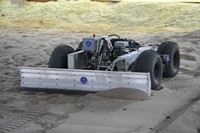Staff from Sudbury’s Northern Centre for Advanced Technology (NORCAT) will be heading to the 9,000-foot level of Hawaii’s Mono Kea in January to field test three rover chassis designed for mining operations on the moon.
NORCAT was contracted by the Canadian Space Agency to develop a rover chassis specifically designed for lunar mining activities, more commonly referred to in the space industry as in situ resource utilization (ISRU).
The not-for-profit technology innovation centre has established a reputation as a centre of expertise in mining technology for space exploration, having won a series of contracts from both the Canadian Space Agency and NASA since 2002, including several contracts for the development of a drill capable of penetrating the lunar and Martian surfaces in search of water.
NORCAT worked with Sudbury-based Electric Vehicle Controllers Ltd. and Ontario Drive and Gear Ltd., manufacturer of ARGO amphibious vehicles, to build the rovers as part of a multimillion-dollar contract awarded last year. Other rovers have been built for space exploration, but none have been specifically designed for ISRU activities, explained Dale Boucher, NORCAT director of innovation.
“I like to use the analogy that I can jump in a front end loader and go down to the corner store for a bag of milk, but why would I want to do that? Alternatively, I can take my Cadillac underground for all of 30 seconds – if I owned one – and it might survive, so the purpose of this project is to try to understand how a mobile platform should be designed for ISRU activities.”
Multiple payloads
The standard chassis accommodates multiple payloads, including a drill, a bulldozer plow, an excavating bucket and a ground penetrating radar unit. The idea is to be able to remove the plow very quickly and swap it for a drill by removing a few bolts.
The unit was designed to keep the payload level even when driving over obstacles and to keep all four wheels in contact with the ground. Off-the-shelf batteries hidden inside the framework supply 2.5 kilowatt hours of power, or three hours of plowing life. A second battery pack can double onboard power. NORCAT could also have used more advanced lithium-ion batteries, but chose not to for purposes of the field test.
Mining know-how is required to support human life during extended missions to the moon, explained Boucher.
“The Apollo missions went to the moon and were there for only 72 hours for a number of reasons, one of which was that they couldn’t carry enough oxygen and water with them to survive any longer.”
In order to support life on extended mission to the moon, NASA and other space agencies around the world are developing technology to turn moon dust into oxygen and water. That, in turn, requires an open pit mine to excavate the material.
“You’d need an area the size of a football field approximately 10 centimetres deep per year to process enough oxygen to keep astronauts alive,” said Boucher. “That doesn’t include water or fuel. It works out to about 10 metric tonnes per year.”
NORCAT is also working with the Canadian Space Agency to develop a means of operating the rovers from Earth.
“Teleoperation isn’t viable because of a whole series of issues, including radio shadows, latencies and the fact that you can only talk to the rovers for 10 minutes every two or three hours,” said Boucher.
Autonomous operation
“So, in January, the task will be to autonomously and robotically build a landing pad without human intervention. We will have a satellite link back to CSA headquarters in Montreal and we’ll have a NORCAT mission commander there who will manage the (field test).”
NORCAT has subcontracted the University of Toronto Centre for Aerospace Studies to apply multi-agent teaming technology designed to allow two or more robots to work co-operatively.
Three rovers with plows will be deployed and given some basic instructions to go out and build a landing pad. The size and location will be communicated. Otherwise, they’ll be on their own, said Boucher.
Xiphos Technologies, another NORCAT partner, has developed a lunar link emulator designed to simulate a radio connection with the moon’s South Pole, the likely destination of a future lunar mission.
The Canadian Space Agency has elected to focus on the development of ISRU technology in recognition of Canada’s world-class mining capability, said Boucher.
Future R&D efforts are expected to focus on developing a way to swap the payload autonomously.



